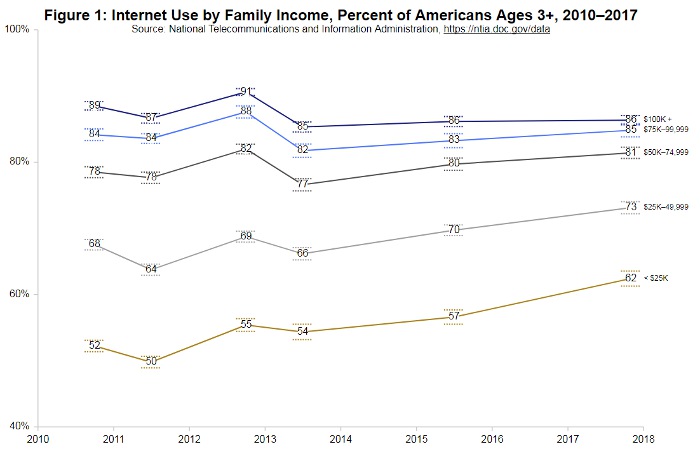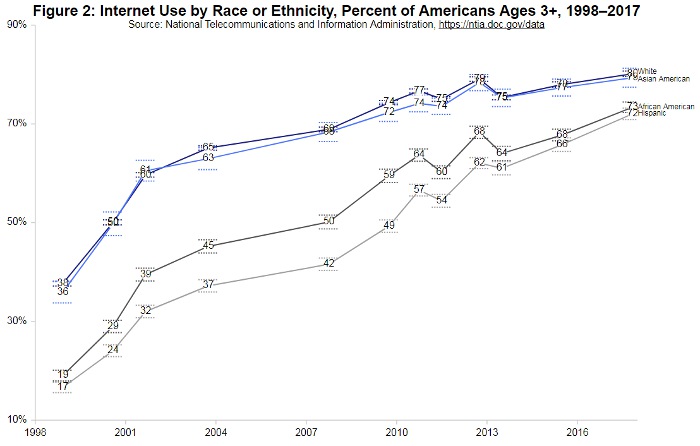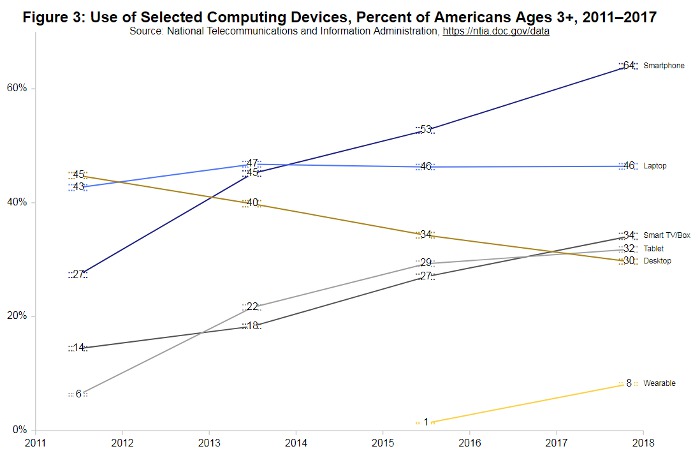Communications of the ACM
Internet Digital Divide Shows Signs of Giving Way

Credit: Getty Images
The digital divide is showing signs of giving way as more Americans from all walks of life connect to the Internet. Several historically disadvantaged groups showed significant increases in online adoption, according to initial results from NTIA's most recent survey on Internet use conducted by the U.S. Census Bureau.
The survey, which was conducted in November 2017, reveals new contours of Americans' Internet use. In 2017, more households had a mobile data plan than wired broadband service. Additionally, for the first time since NTIA began tracking use of different types of computing devices, tablets were more popular than desktop computers among Americans, and the number of people who used multiple types of devices also increased substantially.
Narrowing the Digital Divide
The data show that 78 percent of Americans ages 3 and older used the Internet as of November 2017, compared with 75 percent in July 2015, when the previous survey was conducted. This increase of 13.5 million users was driven by increased adoption among low-income families, seniors, African Americans, Hispanics, and other groups that have been less likely to go online.
For example, among Americans living in households with family incomes below $25,000 per year, Internet use increased from 57 percent in 2015 to 62 percent in 2017, while households earning $100,000 or more showed no change during this period. While the trend is encouraging, low-income Americans are still significantly less likely to go online (see Figure 1).

Similarly, seniors (aged 65 and older) have increased their Internet usage since the last survey to 63 percent, compared with 56 percent in 2015, narrowing the gap with younger Internet users. Internet use among African Americans and Hispanics also continued to climb (see Figure 2). For example, 72 percent of Hispanics used the Internet in 2017—up from 66 percent in 2015, which was itself a large gain from 2013.

Shift to Mobile
Even as more Americans become connected, the ways in which they use the Internet are evolving. Data from 2017 show that more households (88.9 million) had mobile data plans than wired broadband service (85.3 million), a reflection of changing patterns in Internet use.
Americans' computing devices of choice have also changed in recent years. Two years ago, NTIA reported that use of mobile devices such as smartphones and tablets was on this rise, and that continued to be true in 2017. Sixty-four percent of Americans used a smartphone in 2017, compared with 53 percent in 2015, and tablet use increased to 32 percent from 29 percent during the same period. The use of wearable devices such as smart watches and fitness bands—still a nascent product category—grew significantly to 8 percent of Americans, from 1 percent two years earlier. Smart TV and TV-connected device use also continued to increase, growing by seven percentage points to 34 percent from 2015 to 2017.
Laptop use was unchanged at 46 percent of Americans, and desktop computer use continued to slide to 30 percent in 2017—meaning tablet use surpassed desktop computer use for the first time (see Figure 3).

Multiple Device Trends
Americans are continuing to increase the number of devices they use. The proportion of people using at least two different types of devices increased from 52 percent in 2013 to 57 percent in 2015 and then 62 percent in 2017. The use of three or more different device types also increased substantially, from 32 percent in 2013 to 37 percent in 2015 and then 42 percent in 2017.
As many people turn to a range of different computing tools to accomplish different tasks, however, some groups are using fewer devices than others. People in higher income households are more likely to use multiple types of devices. Americans reporting family incomes below $25,000 per year on average used 1.34 different types of devices, while those with incomes of $100,000 or more used an average of 2.77 types of devices—more than twice as many.
The survey, conducted as a supplement to the Census Bureau's Current Population Survey (CPS), included over 123,000 people living in more than 52,000 households in 50 states and the District of Columbia. NTIA has sponsored the CPS Computer and Internet Use Supplement 14 times since 1994, using the results for its Digital Nation research and for data-driven policy analysis and development. With its large sample size and more than 50 questions about Internet usage, it is the most comprehensive national survey of how Americans connect to the Internet and what they do when they're online.
NTIA asked dozens of questions about devices, technologies, and locations of Internet use, as well as online activities, privacy and security concerns, and reasons why some Americans still are not online. NTIA encourages interested parties to try the Data Explorer visualization tool, which allows a user with a web browser to track key metrics over time, by state, and among various demographic groups. NTIA and the Census Bureau will also release the full dataset, which can be downloaded by researchers for use in their own studies. The dataset will be available from the NTIA Research Center in several weeks.
No entries found